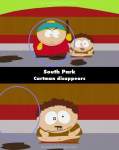Merry Christmas Charlie Manson! - S2-E16
Continuity mistake: In the scene where the Cartman family and boys are seated at table, Kenny sits between Kyle and Great-Grandma. But a few shots later Kyle has to hold Great-Grandma's catheter bag, as he is now sitting next to her, and Kenny is no longer between them. However he's back between them again when the camera shows the whole table. (00:04:30)

Merry Christmas Charlie Manson! - S2-E16
Continuity mistake: When Cartman tells Elvin that he finished his fudgesicle, the two are standing right next to each other. The shot then cuts to focus on Elvin crying, where Cartman cannot be seen next to him. A couple seconds later, when Cartman hits Elvin over the head, the two are right next to each other, but in the shot of Elvin, Cartman cannot be seen next to him.
Merry Christmas Charlie Manson! - S2-E16
Other mistake: When kids go to Nebraska to see Mr Hankey, some kids in the crowd are Butters and Craig and others usual school friends, despite being hundreds of miles from South Park.






Answer: Scottsdale is a well-liked destination for fun; resorts and spas, outdoor activities like hiking and rock climbing, golfing, cultural events, and a bouncy nightlife. It's generally considered an upbeat and convivial place, exactly the sort of environment the gloomy Goth kids would consider to be awful.
Purple_Girl